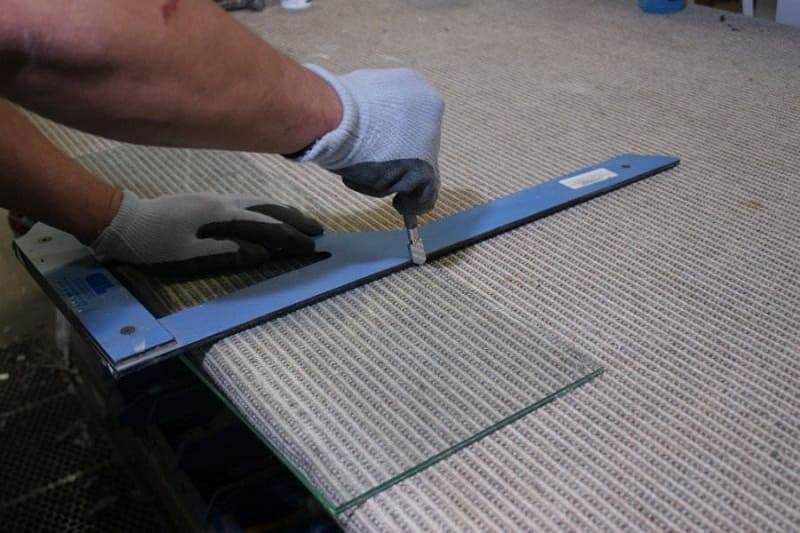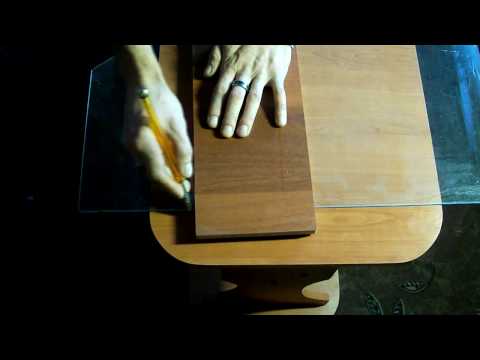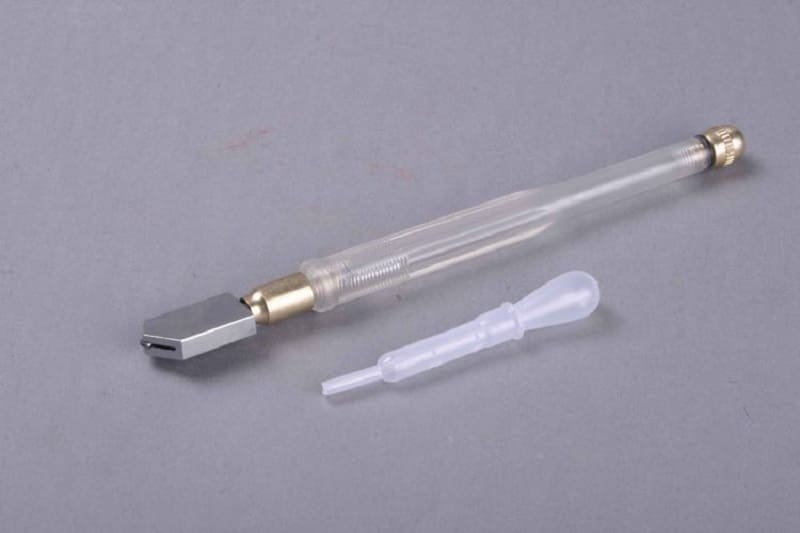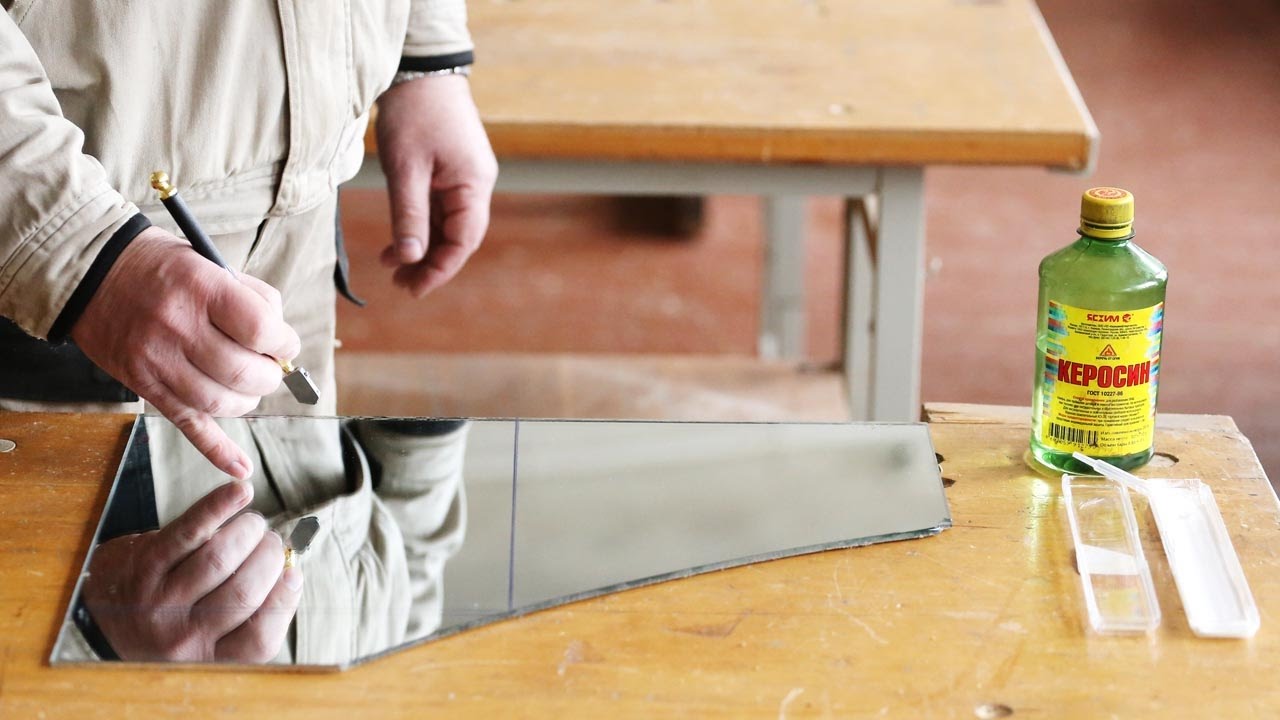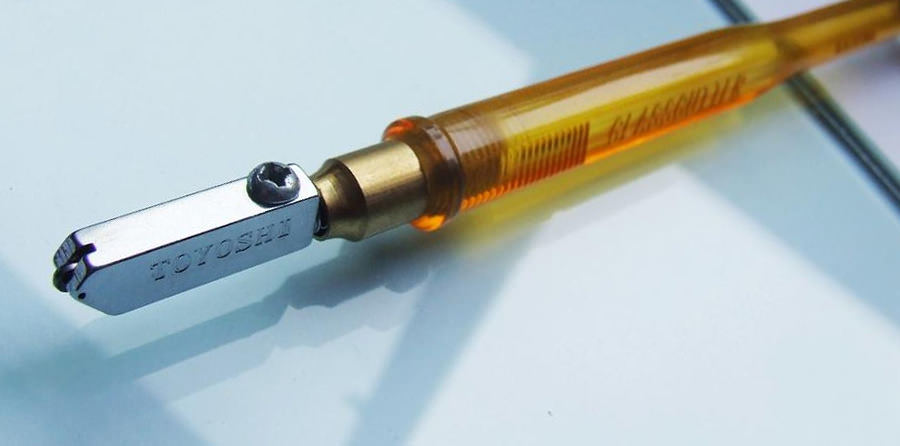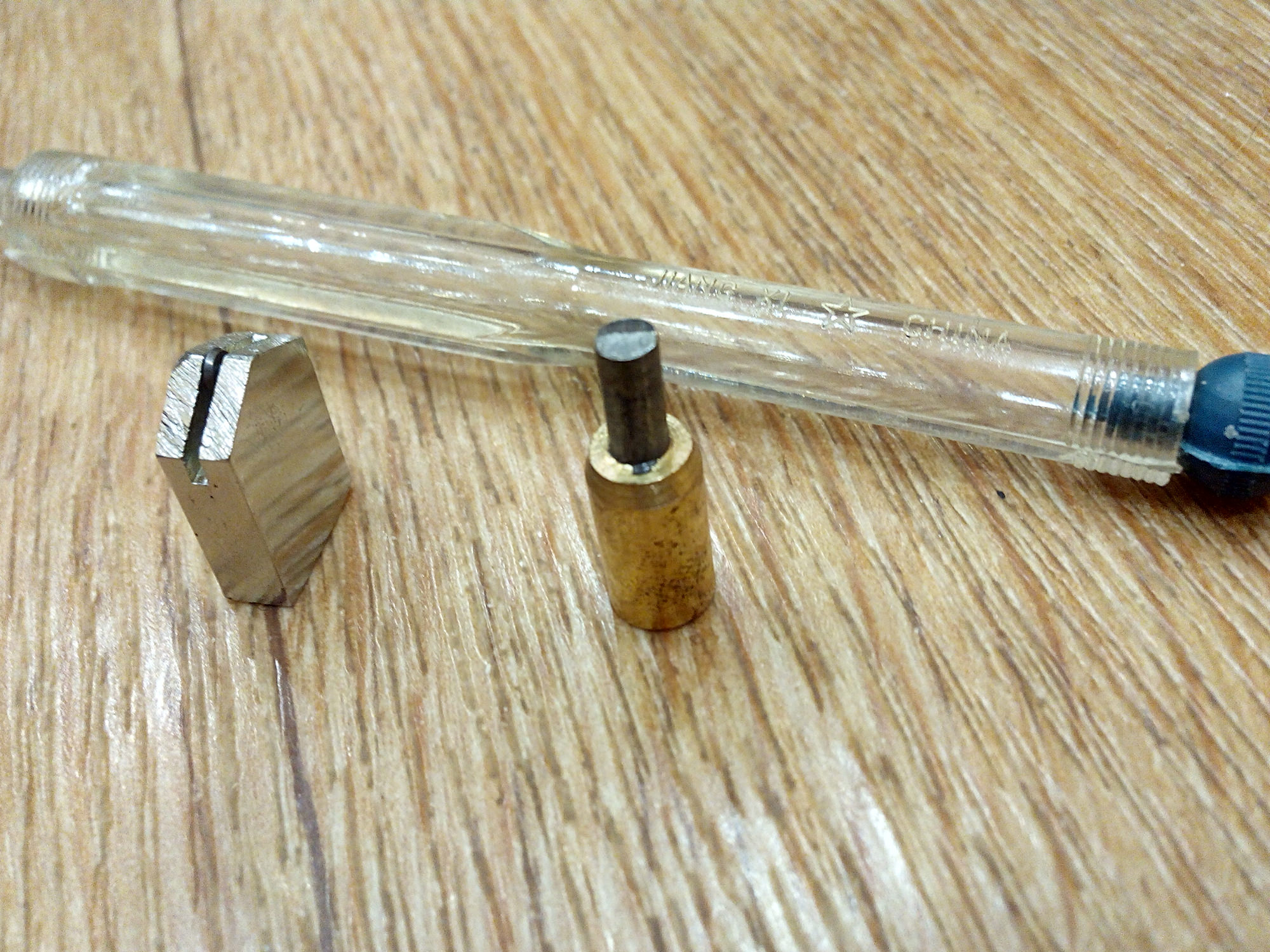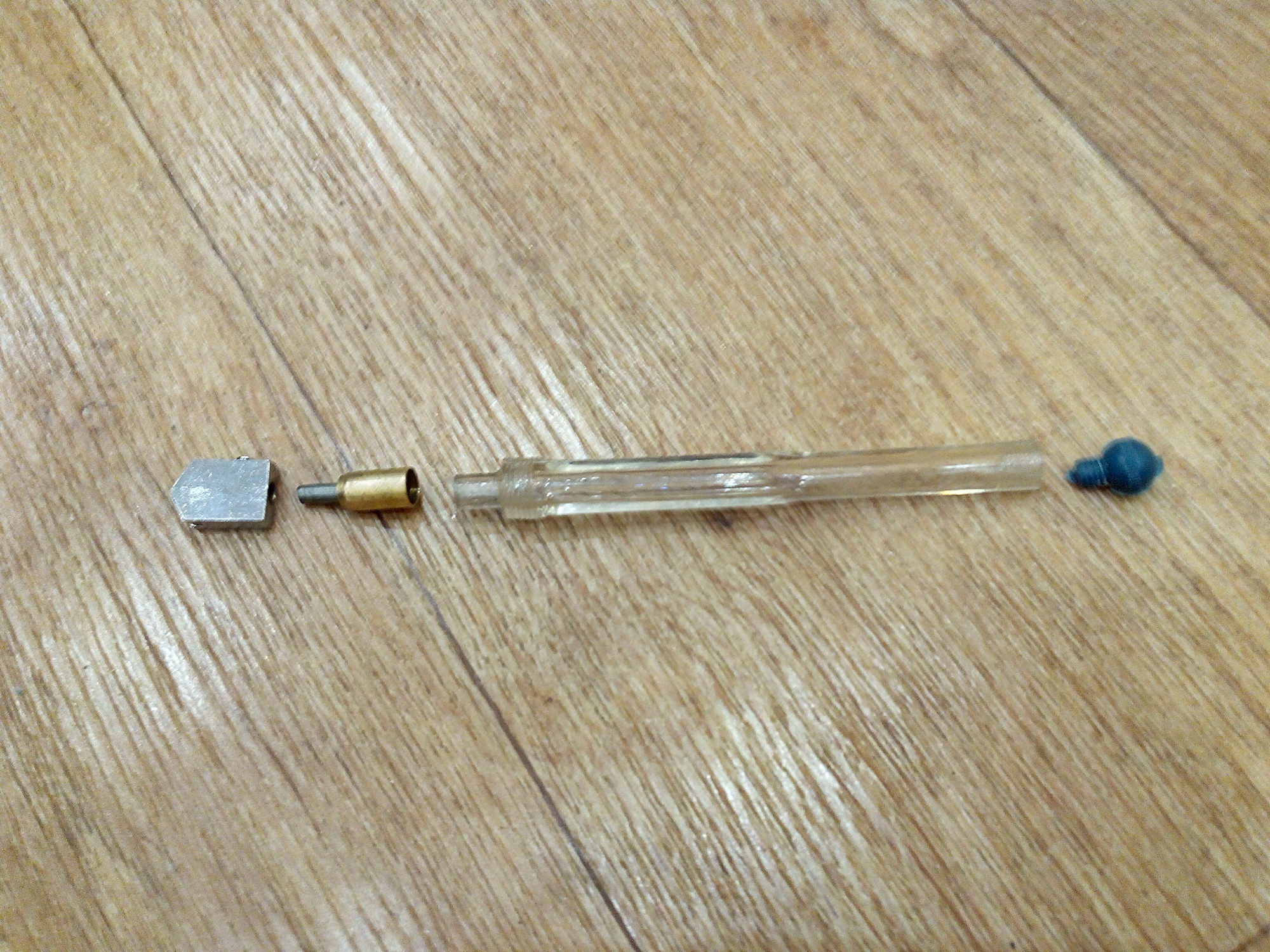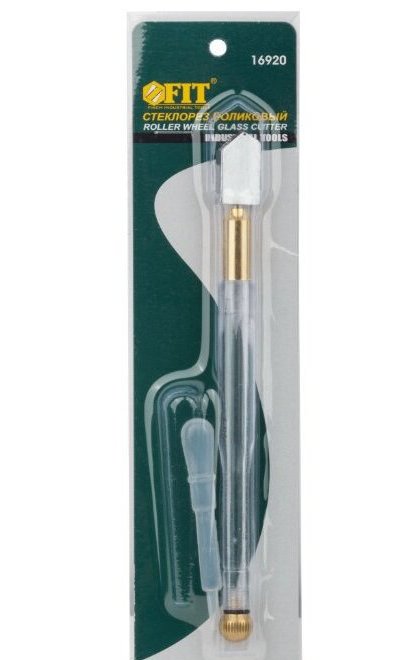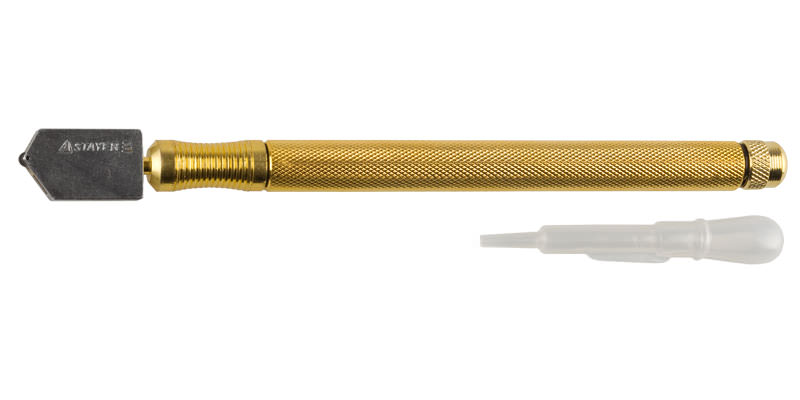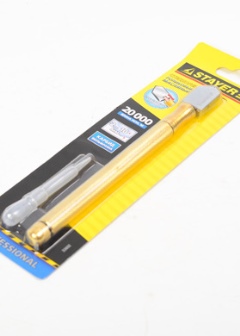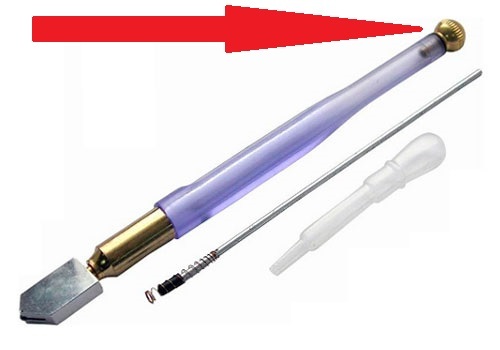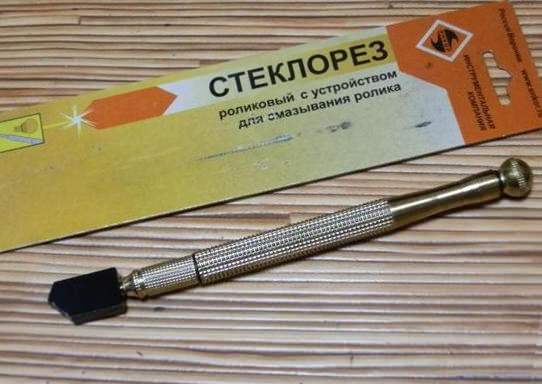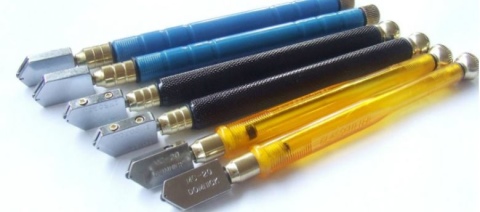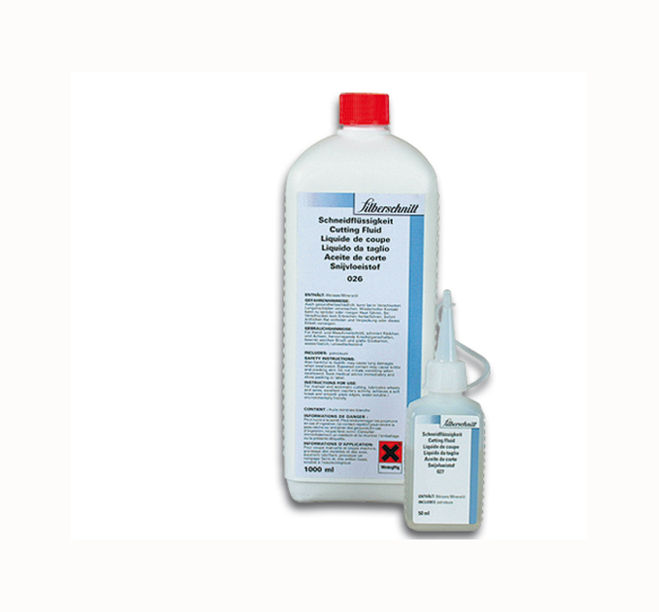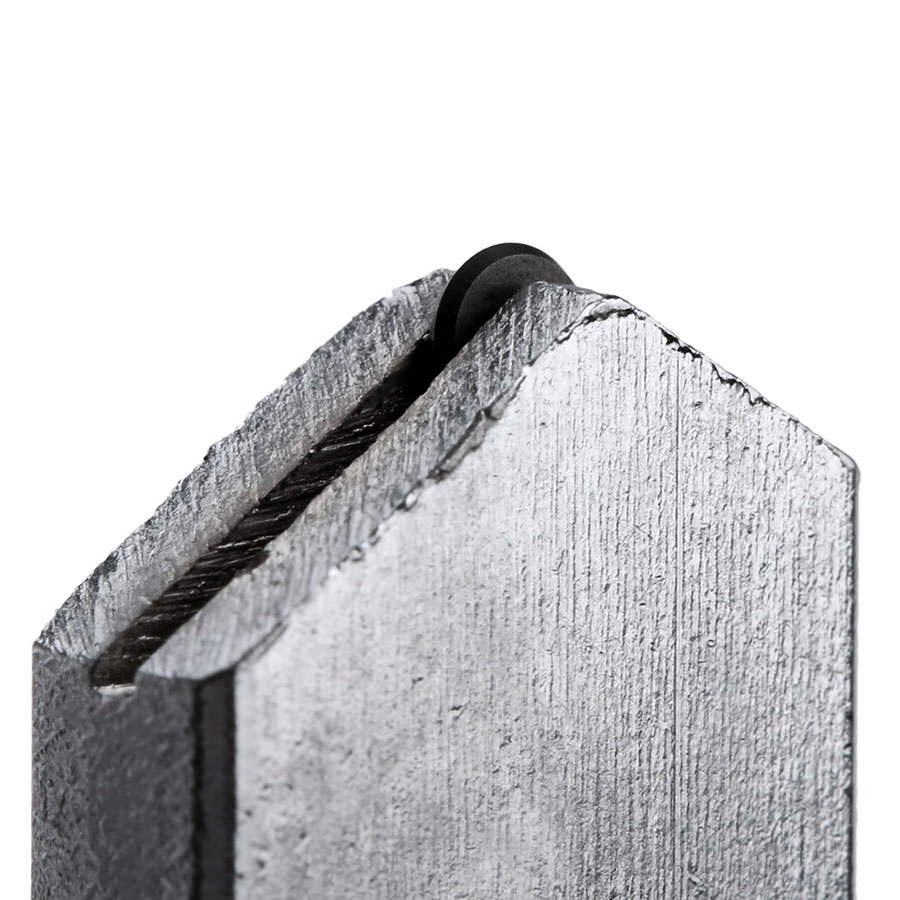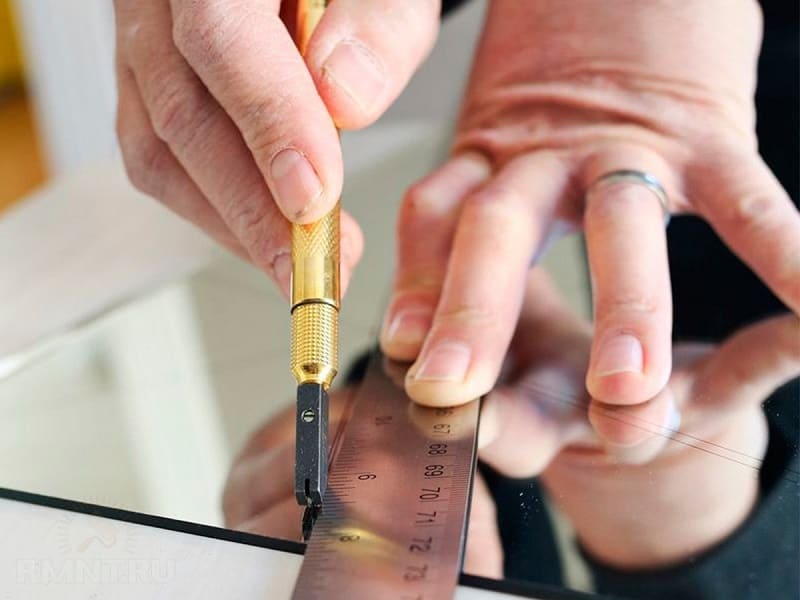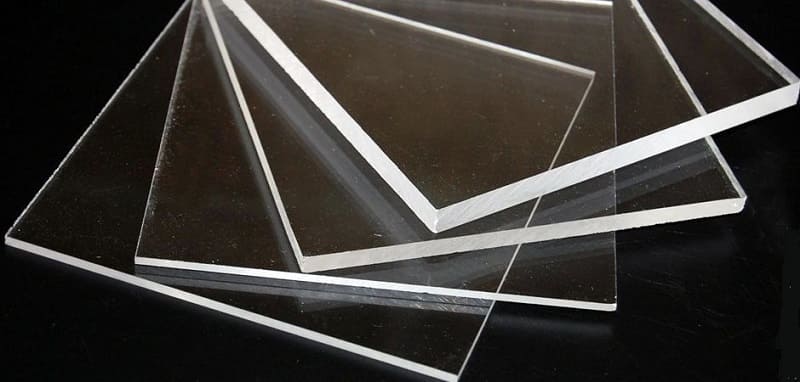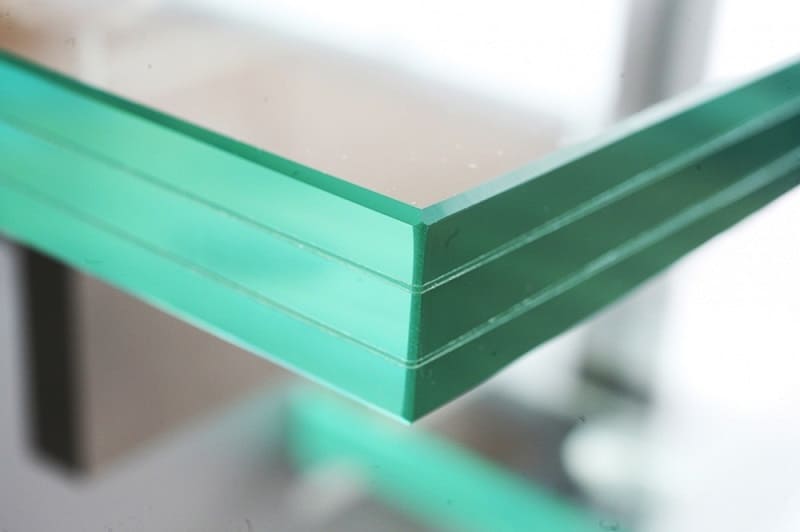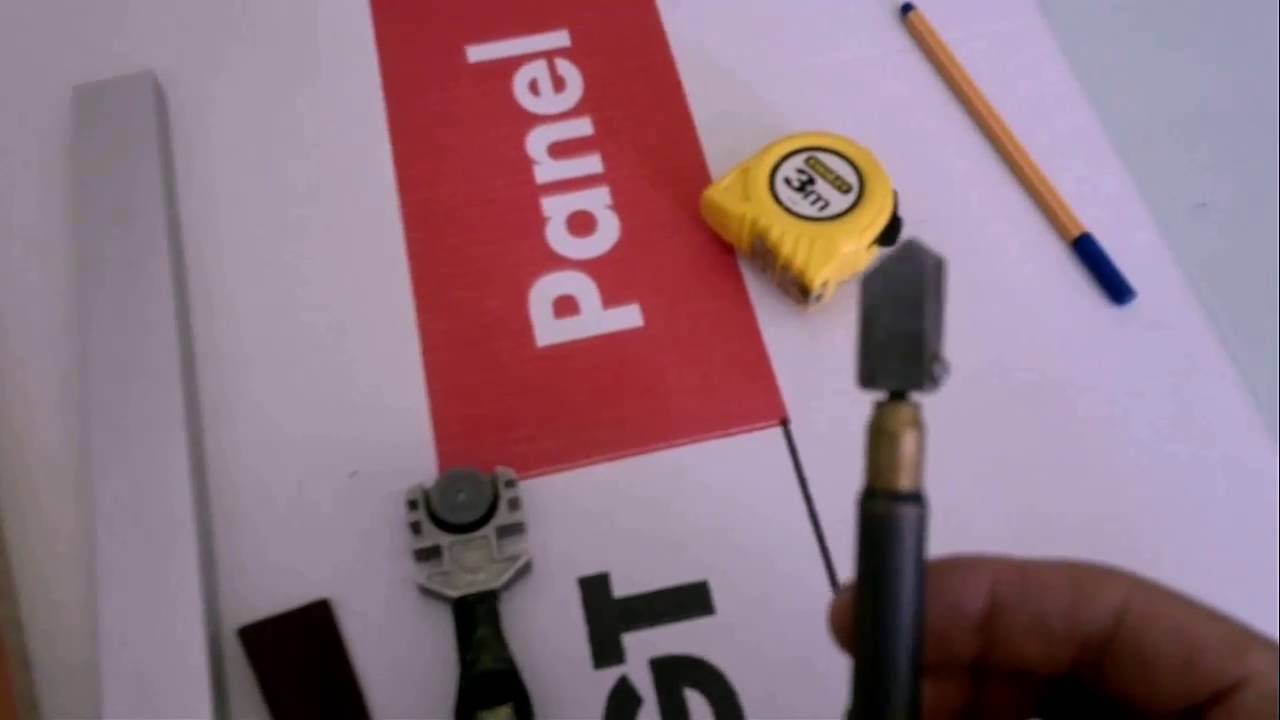How else can you cut glass
What if you don't have a glass cutter at hand? There are ways in which glass is cut with a non-standard tool. This operation can be carried out with a soldering iron, grinder, nichrome thread and even ordinary scissors! Let's find out how cut glass correctly do it yourself in each of these ways.
- With a soldering iron. First, cuts are made with a file at the beginning and at the end of the cutting line. Then, along the entire line, it is necessary to carefully draw with a well-heated soldering iron. Due to the temperature difference on the sides of the surface, the glass will crack, after which it remains only to gently break it off.
- Grinder. This tool is found in almost every home, so it is not surprising that it was also adapted for working with glass. In order to cut off the glass with a grinder, you will need a thin diamond disc. With its help, a thin groove is made along the entire cutting line, along which a chipping occurs in the future. But when cutting with a grinder, you need to make sure that the glass does not overheat, and be sure to use a coolant. A good tool is required, otherwise the glass will simply shatter from its vibration. It is imperative to protect the respiratory organs and eyes when working with a grinder on glass. The smallest glass dust getting into them will not lead to anything good. Therefore, if you cut a sheet of glass with a grinder, you need to stock up on glasses and a respirator.
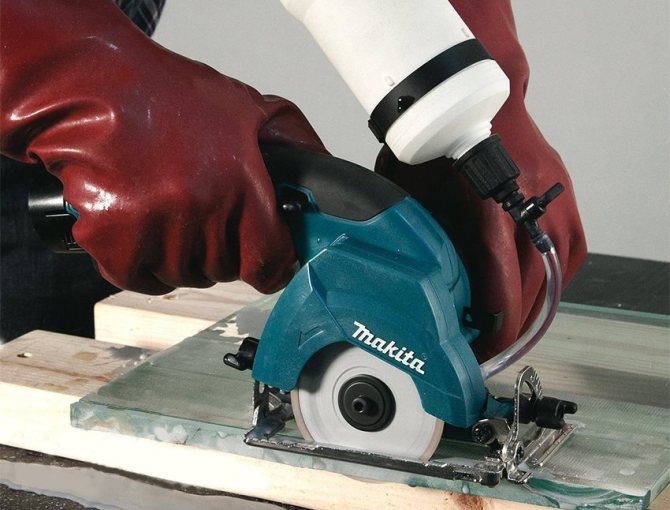
- Using heating and cooling. A thread impregnated with a combustible substance is laid along the cut line and set on fire. Immediately after it has gone out, the cutting line is cooled with water. The glass will crack from a sharp temperature drop. Another option is heating the glass with a nichrome thread through which an electric current passes. In this case, no water is required, the difference in temperature between the two surfaces of the sheet is sufficient.
- Scissors. Non-thick glass up to 3 mm is cut with ordinary tailor's scissors, if this operation is performed by immersing the scissors and glass in a container of hot water. The process feels like cutting thick cardboard.

How to break off glass correctly
Usually thin glasses are broken by hand. Place the cut glass on the edge of the table, so that the cutting line is on top and protrudes slightly beyond the edge of the table top, and most of the glass lies on the table top. With one hand, press the glass to the table, and with the other, grasp the glass by the half protruding from the table. Then, with the other hand, gently push down on the glass.
If the edge to be broken off is too small and there is nothing to grasp with your hand, then break off the glass with pliers. Take the pliers so that the edge of their lips is on the cut line, lightly squeeze the glass and gently push down on the handles. Usually, pliers cannot break off the entire cut strip, so several such approaches will be needed.
Knowing theoretically how to cut glass, take some unnecessary glass and practice on it to get a feel for the tool and fill your hand a little. And then, if you have to cut the glass, the hand itself will remember both the desired position of the glass cutter and the required pressure.
Guide to action
When the surface and material are prepared, you can start working.
For those who cut glass for the first time, the main thing is not to worry.
Safety is more important than the result.
In addition, the quieter the cut, the smoother and smoother the cut line will be.
It is important to follow this sequence:
- The first step is to mark the glass. To do this, you can use a folding rule, ruler or tape measure. Leave marks on the glass with a marker or felt-tip pen, which leaves a thin line, so the result will be more accurate.
- It is also better to lead the glass cutter along a ruler. Remember that the ruler must be of sufficient thickness to prevent the cutter from slipping off when pressed and leaving unnecessary cracks or scratches.
- Taking the glass cutter in your working hand, hold the glass with the other so that they do not move.
- Glass cutters of different types are tedious to hold in their own way. Apply light pressure and at the same time smoothly run the glass cutter along the entire cutting line.
- Cutting must be carried out without fail in one motion. If you have lost pressure, there is no point in walking through this place twice, you can only make it worse.
- After the cut line is drawn, you need to break off a piece of glass. To do this, the entire sheet is shifted to the edge so that the separated part hangs in the air. Grasp the edge of the glass and with a gentle but firm movement break it down.
- The sharp edge at the break-off point can be sanded with a fine diamond file or a file. The main thing is not to put in a lot of effort.
- If there are small pieces left that violate the cutting geometry, you can try to break them off with pliers. In roller glass cutters there are grooves, by inserting a piece of glass into which and pressing, like a lever, you can remove small irregularities.
This sequence of actions has nuances if you use a certain type of glass cutter.
How to use the roller tool?
The roller glass cutter must be held strictly perpendicular to the surface of the glass being cut. The roller must cut with an edge, otherwise the cut will be shallower. It is also not worth tilting the instrument towards yourself or away from yourself - there will be losses on the applied effort.
The pressure with which you need to drive the glass cutter along the line should not be very large, but not small either. You should not lean on the glass, but driving the video without applying force is an empty matter. When cutting, you should hear a small constant crackling sound, this is a sign of normal line passing.
How to use an oil tool?
Since the working cutter in an oil glass cutter is also a roller, it is held in the same way as a roller. The pressure should also be sufficient. The advantage of the oil glass cutter is the lubricant coming from the corresponding compartment in the handle. Professional tools use a special lubricant. It can be replaced with different substances, for example, filled with spindle oil. Volatile liquids are also good: kerosene, white spirit. It is better not to use edible and automobile oil - it is too thick and viscous.
With the proper skill, lubrication prolongs the operation of the roller in an oil glass cutter tenfold compared to cutting "dry".
How to use a diamond tool?
The diamond glass cutter differs from the previous ones in that it has no moving parts. The diamond cutter is rigidly fixed to the metal base of the tool. When cutting, the diamond glass cutter is held at an angle to the surface, with a slight inclination towards you. You need less pressure on a diamond glass cutter than on a roller or oil cutter, so a comfortable grip is the same as when holding a fountain pen. The line remaining behind the incisor should be thin and colorless.
How to cut glass with an oil or diamond glass cutter
Those. the principles and techniques of cutting are almost the same, but the glass does not want to break. Therefore, in order to ensure a reliable cut, a completely different glass cutter is needed. This is the Silberschnidt-2000 of the German company "Bohle"

It has a fixed head body, inside of which there is a carriage with a roller rotating 360 ':
Here is a completely different angle of the roller sharpening, and a special two-valve system for supplying oil to the head, and additional equipment with a special nozzle-handle to give more force when pressing ...
Price: $ 70
Tongs for breaking glass here are also their own, special.
They are no longer as flimsy as the Japanese. Made from milled metal, they weigh almost 1.5 kg! But glass breaks an order of magnitude better.True, their price is already an order of magnitude higher, and at least two. Price: $ 400
For confident cutting of large pieces of thick glass, a special carriage is used, which is put on a ruler and slides along it on bearings. It provides confident, even guiding of the glass cutter and good pressure:
Price about $ 600
For knowingly reliable breaking of thick glass, a special "striker" is used
With its help, the glass is tapped along the cut line from the back side, which leads to the appearance of a through crack at the cut site:
It has an adjustable impact force, making it suitable for different glass thicknesses.
Price: $ 800
If you have to cut complex shapes, especially "inside" glass, then a special spin will come in handy.
Moving it along the cut line, you slowly and carefully move the crack along the cut line by turning the screw, thereby avoiding the danger of it slipping to the side:
Price about $ 800
Now a little about rulers, templates and more:
For the convenience of cutting, there are special rulers with suction cups that attach the ruler to the glass. Well, we will not talk about them - everything is clear here. I will dwell on some of the devices used for more complex things. However, it is worth mentioning the precision squares and sliding template frames for mass cutting of the same parts:
| Price about $ 130 - 200 | Price about $ 150 |
Template for cutting ovals. Use special ring nozzles of different sizes on the glass cutter to cut ovals of different diameters.
Price: about $ 170
Or a more complex device providing a wider range:

Price: about $ 900
Compass device for cutting circles and semicircles. It has a suction cup, which is fixed in the center of the intended circle, and millimeter markings on the rail, along which the glass cutter with a clip walks.
Price: about $ 150
If you made a mistake somewhere, and the thick glass, breaking off, left an ugly "fang", or you need to cut an inner corner, but it is not possible to do this with a glass cutter, a glass sawing machine (like metal cutting machines) will help you:
It has a diamond-coated disc and a water tank (any glass processing, including sawing, requires abundant cooling of the work surface and the working surface of the tool).
Price: $ 300-400
If the “fang” is relatively small, or there is no special machine, or you just need to break off a small piece of glass, then there are special “pliers” for this purpose:
Price: about $ 100
Now a little about glass processing, namely, about drilling and grinding edges:
Glass is drilled with diamond-coated tubular drills along the edge:
This is best done on a machine. Having drilled to about the middle of the thickness, the glass is drilled from the back side. This avoids chipping when drilling through. A constant water supply is required. Large-diameter holes are drilled with a special sliding drill - "ballerina"
Drill prices vary widely, so I will not give them.
Finally, for rough sanding the edges of the glass, you can use surface grinders with an abrasive belt and machines with soft abrasive wheels:

That's all for now. More complete information about all the tools used for manual cutting and processing of glass can be found on the website of the Bohle company
Which glass cutter to choose for glass. How to choose a glass cutter for your home
In almost every household, sooner or later, it becomes necessary to cut glass or a mirror, and if you need to make only a couple of cuts, then there is no point in inviting a specialist (and he will not go for such a small volume). That is why it is better to choose and buy a high-quality glass cutter once. And how to do this, I will tell you below.
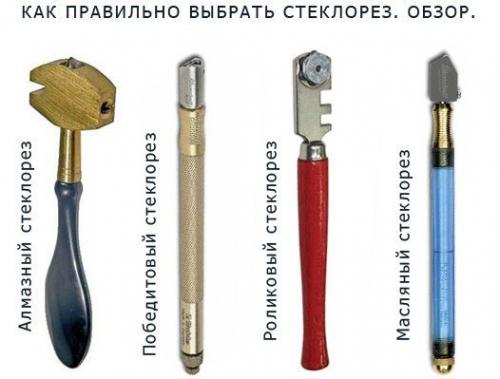
What types of glass cutters are there?
Today, you can find four types of glass cutters on sale, each of which is slightly different from each other in characteristics:
1. Diamond glass cutter. It is a frame with a diamond pebble inserted there. The diamond head is attached to a wooden or plastic handle. A facet of a diamond inserted into a glass cutter is capable of cutting glass up to 1 cm thick, and when the facet becomes dull, the diamond is turned with another facet.

Diamonds on glass cutters are installed of two types: with a curved cutting edge - such a glass cutter is considered an amateur, and a person without experience can use it. The second version of the diamond with a four-sided pyramid is a professional tool, and it will be difficult for a beginner to use it.
When choosing a diamond glass cutter, you need to remember that a diamond can be synthetic and natural, a tool with a synthetic diamond is cheaper, however, only glass up to 5 mm thick can be cut. The rest of the "synthetics" is not inferior to the "natural".
2. Roller glass cutter has established itself as an inexpensive and fairly reliable tool capable of cutting glass with a thickness of 1 to 5 mm, the power reserve of the roller glass cutter is more than 35 meters of glass.
The roller, made of a tungsten-cobalt alloy, is attached to a metal head, which, in turn, is fixed to a wooden or plastic handle. The glass cutter comes with one, three or six rollers, which can be easily changed as they become dull.
3. Oil glass cutter - a modern glass cutter equipped with a special oil container located in the handle of the tool.

Oil is supplied automatically during the glass cutting process, allowing the cutter roller to move smoothly and evenly over the surface, which allows for very smooth cuts and, by reducing friction, increases the tool life. In addition, the oil glass cutter can easily handle glass with a thickness of up to 20 mm. The resource of the oil glass cutter roller is designed for more than 5000 meters.
Oil glass cutters are available with twisting and fixed. The first option is great for pattern cutting of glass, where smooth lines are needed.
4. Compass-glass cutter is not widespread, since it is not often necessary to cut circles or ovals on glass (most often it is not necessary at all). The glass-cutter compass consists of a suction cup, with which the tool is attached to the glass, a scale, with which the required circle diameter is set, and an oil glass cutter.
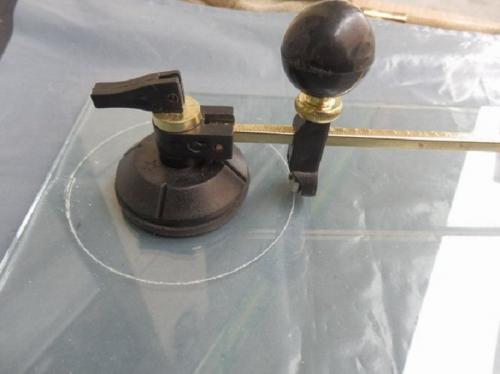
As you can see, choosing a glass cutter is not as difficult as it might seem at first glance.
Friends! Subscribe and like, there will be many more interesting things!
How to choose glass cutter oil?
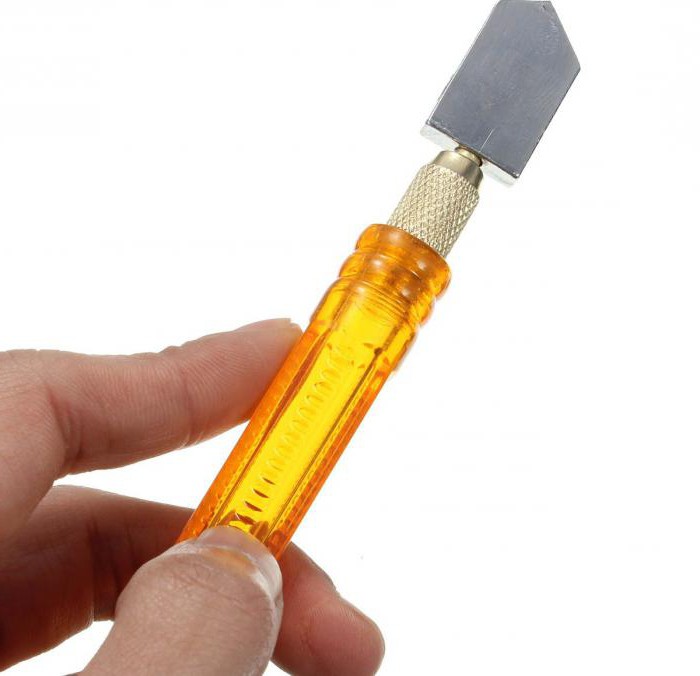
There are not many requirements for oil, but the duration of the tool's operation depends on their compliance. First of all, the mixture must have a consistency sufficient for free passage into the feed channel. Otherwise, automatic lubrication simply won't work. The second condition is reduced to optimal adhesion - a sufficient coefficient of viscosity of the composition will make it possible to uniformly lubricate the oil glass cutter. The instruction for the tool recommends using a mixture of engine oil and kerosene diluted in equal proportions as the best option. In practice, high-quality compounds flow steadily from the reservoir to the working head and remain on it. During the cutting process, the oil may leave a streak of mark, but it should not flow out abundantly from the cutter.
How and what to refuel and how to work with an oil glass cutter?
Oil glass cutter has recently appeared in the arsenal of glass cutters. In principle, this is the same roller glass cutter equipped with the function of automatic lubrication to the cutting element. The oil reservoir is aligned with the handle of the glass cutter, and the liquid flows through the wick directly to the roller, simultaneously lubricating its axis.
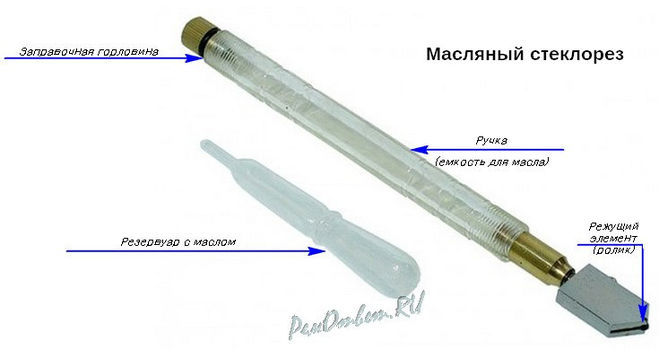
Such a system makes it possible to reduce friction in the roller axis, ensuring its smooth movement, binds the smallest glass particles that are formed during the cutting process.
In order for the oil glass cutter to work properly, it must be filled with special oil. Such oil has one important feature - it is washed off with water !, and besides, it does not drain from the roller axis and the roller itself and does not spread over the glass.
Of course, instead of special oil, you can use other types of oils, up to the spindle, as long as it has a fluidity that can be freely supplied to the cutting element through the wick. You can use turpentine, kerosene, white spirit, etc.
But such a replacement is highly undesirable, because:
First, as mentioned above, all these substances are poorly removed from glass. You will have to allocate additional time and money to purchase special fluids to clean it from greasy stains.
secondly, the use of such substitutes in a very short time will disable your instrument.
Special oils used for oil glass cutters:

Silberschnitt, Milli M2000, T-3133, BOHLE, EnviroGOLD, Novacan Cutter Oil, etc.
Oil is poured into the handle-reservoir for 2/3 of the total volume. In order for the oil to flow evenly and correctly during operation, its supply is regulated using a cap. Turning the cap in one direction or the other, they achieve that an even and damp strip is obtained on the glass. At the end of the work, unless a long break is foreseen, the oil can be left in the cutter, otherwise it is better to drain the oil.
The basic techniques for cutting and preparing material when working with an oil glass cutter are the same as with a diamond one. (See here, on RemOsvet).
And in conclusion, a short video on the topic.
An oil glass cutter is not much more difficult to work with than a regular roller cutter. The principles of handling them are the same, with the only difference that the oil glass cutter (as the name implies) also has a supply of lubricating fluid to the cutting site.
What to refuel. The most budgetary option for a lubricating composition, for an oil glass cutter, is engine oil diluted with ordinary kerosene, in a one-to-one ratio. Anyone can make such a lubricant. Oil with kerosene has a lower viscosity due to which it penetrates to the roller and at the same time is not devoid of lubricating properties. Engine oil with kerosene does not affect the resource of the roller, nor does it affect the quality of the cut. The only drawback of such a cocktail is that it is more difficult to wash it off with water.
Special oils for oil glass cutters are no better in their lubricating properties than diluted kerosene oil, but they are much more expensive. Their indisputable advantage can only be attributed to the fact that they are water-soluble and wash off well, because they consist of heavy esters of an oily consistency. If you nevertheless made a choice in favor of a special tool for an oil glass cutter, then T-3133 oil, Russian production, is quite suitable as it. The price for two hundred grams is not more than 250 rubles. For a home craftsman, this jar will last ten years. Washes off without leaving streaks. From foreign there is a good liquid SOGEVER 1000 FG. This one does not require rinsing at all, it evaporates completely on its own. True, and it costs about five thousand per liter. I have not seen it in a small container. Mainly used for automatic glass cutting and critical glass work of contour cutting (wave cutting)
How to work? An oil glass cutter, in contrast to a roller (dry) or diamond cutter, requires a minimum of preparatory work - it is just to pour the lubricating liquid into the tool handle. The rules for cutting with an oil glass cutter are the same as for the others - the glass must be clean, laid on a flat hard surface. Before the end of the cut, the pressure is released. You cannot make one cut several times - we will spoil the video.Glass with a thickness of more than 5 millimeters must be cut from both sides, two cuts opposite each other.
How to choose the right glass cutter
There are several varieties of such a tool:
- oil;
- roller;
- curvilinear;
- diamond.
For cutting glass at home, you can use each of the options. However, they all differ in design and properties. It is necessary to study in more detail the process of cutting with different types of tools, then an idea of their intended purpose will be formed. So, the device of an oil glass cutter is in many respects similar to a roller analog, however, such a model provides a reservoir for filling lubricant.
If the surface is lubricated with oil during cutting, the rate at which the cutting edge develops is significantly reduced, which is due to a decrease in the intensity of friction. The lubricant is supplied automatically, which simplifies and speeds up the work. A reservoir containing oil is located in the handle. The service life of the tool is 5 thousand meters. It can be used to work with material no thicker than 20 mm.
When the glass cutter stops cutting the glass efficiently, the cutting edge can be replaced. Unlike a conventional glass cutter, the oil model can be equipped with a fixed and movable (rotating) head. The last of the options is for making bends. The design provides for 2 options for the location of the head: with a sharpening angle of 135 and 150 °. In the first case, the tool can cut material no thicker than 10 mm, in the second - up to 20 mm. More about oil glass cutter in the video:
If you need to choose a glass cutter, you need to consider the roller model. In this case, the head is movable. Cutting material: tungsten and cobalt. The number of rollers may differ, more advanced models are equipped with 6 of these elements, but they are also more expensive. Standard glass cutters work with glass up to 4 or 6.6 mm thick.
The curved tool is designed for making bends and intricate patterns. The roller can make circles, ovals and other geometric shapes. By its structure, it resembles a compass. The tool is equipped with a suction cup, through which it is attached to the material, and the main part containing the cutting edge, the handle. The design provides for an adjustable scale and a system of two rods, by means of these elements you can make a radius characterized by the required parameters. Scissors are also used as an alternative cutting method.
Diamond glass cutter
The main structural element is a diamond crystal. The location is the bottom of the instrument. With its help, glass is cut with a diamond glass cutter. The cutting element can be artificial and natural, in accordance with this, the restrictions on the use of the tool differ. In the first case, the material should be up to 5 mm thick. This model is inexpensive. It fully justifies its properties. For household needs, this glass cutter is enough.
Natural diamond can cut thicker material than artificial, but it gradually dulls. To restore the function of the glass cutter, the cutting edge must be sharpened using a disc or bar. The degree of sharpness of the tool is checked by touching the glass: if a thin cutting line is visible, then the cutting edge is ready for work. This model is presented in two versions:
- curvilinear;
- with a square cutting edge.
The service life of the diamond tool is 10 thousand meters.
Features of oil glass cutters

As the name implies, such models are distinguished by the fact that the working mechanisms are lubricated with oil. The rest of the tool resembles traditional roller glass cutters. Actually, due to the presence of automatic lubrication, this option is more profitable from the point of view of long-term or intensive use.The fact is that the oil roller glass cutter during operation does not imply strong friction of the working head, which increases the service life. Conventional roller models, on the other hand, do not have a lubrication system and are therefore less durable. However, those who rarely deal with glass processing may well turn to the standard versions without lubrication. There are also diamond glass cutters. They do not require the use of oil, but at the same time they have a long service life. True, oil counterparts are cheaper.


